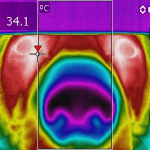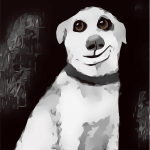The Projects
EMOMETER - Assessment of emotional functioning in dogs
 EMOMETER (short for EMOtionMETER) is an EU-funded research project with the title “Developing an integrated toolbox for the assessment of emotional functioning in dogs”. The aim of this project is to find appropriate non-invasive tools to measure emotional states in dogs to achieve a better understanding of their emotional lives and to achieve and strengthen satisfactory human-dog bonds.
EMOMETER (short for EMOtionMETER) is an EU-funded research project with the title “Developing an integrated toolbox for the assessment of emotional functioning in dogs”. The aim of this project is to find appropriate non-invasive tools to measure emotional states in dogs to achieve a better understanding of their emotional lives and to achieve and strengthen satisfactory human-dog bonds.
Paw preference and personality in dogs

Do you know if your dog is left- or right-pawed?And what does that tell you about your dog’s personality?
Not only humans prefer to use a certain hand for specific activities such as writing, using tools or holding cutlery. Dogs also show individual preferences when using their paws, for example, some dogs preferentially use their right or left front paw to stabilize a food-stuffed Kong™ while other dogs use both paws equally. Moreover, individual paw preference seems to be related to differences in traits like aggressiveness, playfulness and sociability.
Lateralization in Dogs

 This project investigates lateralization as a non-invasive tool to measure emotional activation in dogs.
This project investigates lateralization as a non-invasive tool to measure emotional activation in dogs.
Finished projects
Comparison of visual and auditory functioning between dogs and humans

 “I spy something with my little eyes (and ears)….”. This old children’s game would reach another level, if you would like to play it with animals. While humans act on an anthropocentric view of the world, assuming that experiences of others are similar to theirselves, the reality is that animals senses most likely function in a totally different way than human ones. The second reality is that we often do not understand how their senses are functioning, resulting in a lack of knowledge how they perceive their world. Having this basic knowledge and appreciating differences and similarities is especially important when considering that there are animals that live and act in close relation to us, that are our companions and guardians, that rely on us and that we sometimes trust with our lives – yes, I am talking about dogs.
“I spy something with my little eyes (and ears)….”. This old children’s game would reach another level, if you would like to play it with animals. While humans act on an anthropocentric view of the world, assuming that experiences of others are similar to theirselves, the reality is that animals senses most likely function in a totally different way than human ones. The second reality is that we often do not understand how their senses are functioning, resulting in a lack of knowledge how they perceive their world. Having this basic knowledge and appreciating differences and similarities is especially important when considering that there are animals that live and act in close relation to us, that are our companions and guardians, that rely on us and that we sometimes trust with our lives – yes, I am talking about dogs.
How do humans care for their dogs?
 Humans have a duty to care for pets. Yet there is a wide variety of different methods, believes and attitudes of caring for pets, with limited knowledge of what is right. This study investigates the different ways, which pet dogs are looked after, aiming to gather a broad overview of owners effort for e.g. physical activities over nutritional to medical care.
Humans have a duty to care for pets. Yet there is a wide variety of different methods, believes and attitudes of caring for pets, with limited knowledge of what is right. This study investigates the different ways, which pet dogs are looked after, aiming to gather a broad overview of owners effort for e.g. physical activities over nutritional to medical care.
Why and when do dogs show “submissive grinning”?

Submissive grinning, sometimes also called smiling, in dogs is a behavior commonly monitored in situation of greeting. It has been argued that submissive grinning functions as an appeasement gesture and is used to communicate harmlessness and possibly actively solicit attention, inviting interactions from others. However, there are also arguments that this gesture can aim to increase distance between the dog itself and other individuals in threatening situations.
Consider my Nose - How does nose length effect social cognition in dogs?

Toy breeds are increasingly popular as pets. Given that the majority of them is brachycephalic (i.e. short nosed), their popularity might be due to range of features attractive to humans (evoking a “cute” response), such as large heads, flat faces and big eyes. However, it has also been shown that some of these facial features are associated with structural differences in eye anatomy, suggesting that they may be better adapted to and favoured living in a human environment.
How does "censoring" of the face affect dog-human-communication?
 We are investigating how particularly dog owners and their dogs are affected by the COVID-19 pandemic. This study consists of DIY studies investigating dogs’ abilities for face and emotion processing and the impact of the use of face masks on this.
We are investigating how particularly dog owners and their dogs are affected by the COVID-19 pandemic. This study consists of DIY studies investigating dogs’ abilities for face and emotion processing and the impact of the use of face masks on this.
Function and cause of head tilts in dogs

Head tilting responses in dogs are adorable. But are there other functions of head tilts in dogs besides making your heart melt?
Anecdotally, dog do tilt their heads, when they are “puzzled” by something. However, there are also speculations that head tilting responses in dogs improve hearing or vision. Others claim, that head tilts provide advantages for social interactions and communication. In two projects we will approach the various rumors and speculations why dogs tilt their head scientifically.
